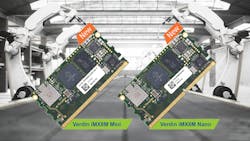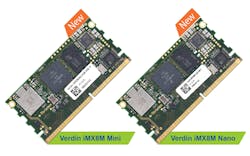Streamlining Embedded-Computing Design with COMs
Using computer-on-module (COM) hardware allows designers to concentrate on their applications. It can also simplify the design of the carrier board. To that end, a number of COM vendors provide a range of solutions.
I spoke with Daniel Lang, Chief Marketing Officer at Toradex, about COM and system-on-module (SOM) solutions. Also discussed were the challenges faced by designers and how these platforms help streamline the design process.
What would you say is the most common misconception people face while choosing a computer-on-module?
I think for many, it’s challenging to make an objective judgment of the total-cost-of-ownership when comparing COMs with each other or with other solutions such as chip-down designs…this isn’t intuitive because many different stakeholders are involved. Most understand the time savings in the hardware-development phase, but typically for products that are shipped for years, maintenance of software and hardware is a major part.
Then there’s the software stack. Software support can be quite different between different COMs, such as the quality and scope of the available software, the ecosystem, long-term support, online resources, and more. Other points to consider are the risk and opportunity costs associated with a slower development process.
How is the industrial automation landscape changing in your opinion?
One of the most significant changes we see is that now almost all devices are connected. Frequent features or security updates are common requirements. Another development is that Arm-based systems are now capable of higher-performance tasks typically reserved for x86-based systems, including machine-learning tasks at the edge.
And how do you fit in?
Toradex focuses on making embedded computing easy. We do so by providing COMs with tightly integrated software support concentrating on simplifying the development and maintenance of modern devices in verticals such as industrial automation, healthcare, smart city, transportation, and test and measurement. Toradex is also cultivating a rich ecosystem of software, hardware, and engineering companies to help our customers bring successful products to market.
Tell us about your latest offerings this year.
This year, we introduced Verdin (see figure), our new family of COMs/SOMs. The first of the SOMs in this family feature the NXP i.MX 8M Mini and Nano applications processors, and we’re working on a version with the NXP i.MX 8M Plus that features neural-network processors.
On the software side, we rolled out Torizon, an open-source easy-to-use industrial Linux platform. Torizon enables people who like to focus on their application and not on building the OS. It’s also designed for easy updatability.
What sets the Verdin apart?
Verdin is based on Toradex’s 15 years of experience with edge-connector-based SOMs. We incorporated everything we learned over the years, including feedback from customers.
Verdin is ruggedized, comes with wireless connectivity options, and features “Direct Breakout” for simple carrier-board designs. We also provide simple yet advanced power management, which extends to carrier-board peripherals and is battery-ready. As with all Toradex SOM families, the modules are pin-compatible, allowing for scalability and upgradability.
Also, as is the case with all Toradex products, Verdin comes with extensive documentation and reference designs to simplify hardware development. Verdin is integrated with the Gumstix online carrier-board design tool as well.
How do you compare with the likes of popular maker boards?
Toradex compares with the popular maker boards in its ease of use. You don’t need a master’s degree in electrical engineering to get started. We put a lot of effort into making the developer experience simple for applications in our target markets.
The big difference is that Toradex SOMs are optimized for volume production in applications requiring high reliability. The modules are designed to run 24/7 for many years. That means the SoC, RAM, flash, etc. are qualified very differently.
As an example, take a look at the i.MX 7 Product Life Time Usage. Toradex also provides minimum availability of 10+ years, industrial temperature range, and many more features that are interesting for industrial and medical applications but probably not relevant for makers.
I’ve been reading a lot about Torizon. Tell me about the inspiration behind that offering?
That’s a very good question. Toradex is well-known for having an extremely easy-to-use operating system out-of-the-box, which could be deployed directly to critical applications with our Windows Embedded Compact. On the Linux side, Toradex focused on providing a rock-solid BSP based on the Yocto Project, thereby giving customers maximum flexibility in building their own Linux distributions.
However, we found that this was too overwhelming for some customers and that they like to have a ready-to-use production OS. Another inspiration was the many changes in requirements, in particular, we know that 90% of future applications will be connected. This requires a solution that’s easy to maintain in the field for many years. This typically means frequent updates and customers looking to deploy modern DevOps concepts for their embedded products.
We also did extensive customer research and surveyed over 2000 people. All that input led to the creation of Torizon. One of the main components is the open-source Linux built with Yocto Project called TorizonCore. It has a real-time option and includes and automotive-grade update client and a Docker runtime. But Torizon is more than just the OS—it provides integration with IDEs, upcoming offerings around update services, security, and more.
What’s next for Torizon?
Currently, Torizon provides tight integration with popular IDEs such as Visual Studio and Visual Studio Code. We’re collaborating with Qt to simplify the development process further. And we’re working on an Update Infrastructure currently available via Toradex Labs. Moreover, we’re investing in simplifying security and further building the ecosystem around Torizon.
What do you see coming up in 2021? Anything you can talk about?
On the hardware side, we’re very excited about the new addition to Verdin featuring the NXP i.MX 8M Plus with the neural-network accelerator. Toradex already has a good footprint in vision and machine-learning applications, and this will provide a high-performance, low-power solution extending the possible applications. We will also extend the offerings around our Torizon Platform, such as an over-the-air update service, improvements in security, and extending the ecosystem of partners and software.
Daniel Lang studied electrical engineering in Switzerland. In Daniel’s early career, he worked for a big elevator company to connect them to the internet. Daniel joined Toradex in 2005, when the company launched its first product.
Initially, Daniel worked on driver development and helping customers to integrate Toradex’s modules. Over 10 years ago, he moved to Seattle, where he now serves as Chief Marketing Officer for the company globally.
About the Author
William G. Wong
Senior Content Director - Electronic Design and Microwaves & RF
I am Editor of Electronic Design focusing on embedded, software, and systems. As Senior Content Director, I also manage Microwaves & RF and I work with a great team of editors to provide engineers, programmers, developers and technical managers with interesting and useful articles and videos on a regular basis. Check out our free newsletters to see the latest content.
You can send press releases for new products for possible coverage on the website. I am also interested in receiving contributed articles for publishing on our website. Use our template and send to me along with a signed release form.
Check out my blog, AltEmbedded on Electronic Design, as well as his latest articles on this site that are listed below.
You can visit my social media via these links:
- AltEmbedded on Electronic Design
- Bill Wong on Facebook
- @AltEmbedded on Twitter
- Bill Wong on LinkedIn
I earned a Bachelor of Electrical Engineering at the Georgia Institute of Technology and a Masters in Computer Science from Rutgers University. I still do a bit of programming using everything from C and C++ to Rust and Ada/SPARK. I do a bit of PHP programming for Drupal websites. I have posted a few Drupal modules.
I still get a hand on software and electronic hardware. Some of this can be found on our Kit Close-Up video series. You can also see me on many of our TechXchange Talk videos. I am interested in a range of projects from robotics to artificial intelligence.



